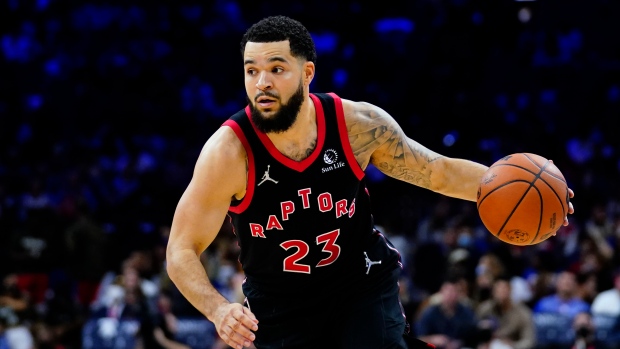Nov 26, 2021
Calling Bank: What we’ve learned from Raptors’ road trip
The Toronto Raptors will wrap up their six-game road trip against the Indiana Pacers tonight. The first five games of the trip have provided a balanced mix of winnable and challenging games, providing a snapshot for how the rest of the season might unfold.

The Toronto Raptors will wrap up their six-game road trip against the Indiana Pacers tonight.
The first five games of the trip have provided a balanced mix of winnable and challenging games, providing a snapshot for how the rest of the season might unfold.
They faced some wily vets, some speedy youngsters, and some disruptive centres hounding the paint.
Toronto will finish the trip as an underdog in all six games, but Raptors fans know both Sacramento and Memphis were gettable games. The Kings were technically the only team with a lower win projection during preseason.
Even though OG Anunoby went down with a hip injury after the first game, there were some key lessons – both short and long term – that relate to betting.
Here are some observations that stood out to me.
Trouble scoring in the paint
Four of Toronto’s first five opponents featured starting centres who rank in the top 100 in Defensive Box Plus Minus (a per game stat that measures defensive performance versus a league-average player). Memphis centre Steven Adams was the one rim protector that has a negative grade.
In the first four games, the Raptors went 60-for-136 (44.1 per cent) in the restricted area. Against Memphis, they shot 22-for-35 (62.8 per cent).
Of Toronto’s top scorers, here is a list of their shot distribution (field-goal attempts at the rim versus total field-goal attempts):
Gary Trent Jr: 14-of-84 shots (16.6 per cent)
Pascal Siakam: 28-of-70 shots (40 per cent)
Fred VanVleet: 20-of-76 shots (26.3 per cent)
Scottie Barnes: 30-of-58 shots (51.7 per cent)
Trent and VanVleet weren’t as impacted by elite rim protectors given their three-point volume. However, a guy like Barnes, who gets half his shots at the rim, really suffers. The rookie forward scored six of his eight field goals in the paint versus Memphis. In the other four games, he went 7-for-21 at the rim (33.3 per cent). For perspective, the league average at the rim is 57.3 per cent.
Key takeaway: Fade Barnes when Toronto faces quality rim protectors.
Hot from three
The Raptors have hit the over on their game totals in six of their past seven games (Sacramento being the exception). Half of the story is poor defence, but the other half is Toronto’s red-hot shooting from deep.
The return of Siakam is a big part of the scoring boost. His presence as a primary playmaker cutting to the rim is drawing defenders away from the perimeter and leading to more three-point opportunities.
Three-point shooting attempts from the past five games:
VanVleet: 8.4 attempts
Trent Jr.: 8.6 attempts
Svi Mykhailiuk: 3.6 attempts
Barnes: 1.8 attempts
Three-point shooting attempts from the first 14 games:
VanVleet: 7.8 attempts
Trent Jr.: 6.7 attempts
Mykhailiuk: 2.9 attempts
Barnes: 0.8 attempts
One can only wonder how much better the team scoring would be once Anunoby returns from his hip injury.
If you read any of my previous articles this season, I’ve noted that scoring is down league-wide by roughly five points per team. Oddsmakers have adjusted game totals to reflect this and with the current form Toronto’s playing at, now might be a good opportunity to zig when the lines are zagging.
The Raps are shooting 39.1 per cent from three on this road trip. They averaged 33.8 per cent in the 14 games prior.
Key takeaway: Toronto’s scoring efficiency and poor defensive should translate to higher scoring games.
Slow pace limiting opponent rebounding
All the credit to the Raps, they own the league’s highest offensive rebounding rate at 33.8 per cent. On the flip side, they average the second-fewest defensive rebounds per game, just behind Detroit.
While fans have witnessed Toronto give up a ton of uncontested second chance points during this road trip (fourth worst in the NBA at 14.2 per game), they play at such a slow pace that opposing teams mathematically get fewer rebounding chances per game.
The Raps are on a wild streak – they’ve held opponents below their season average in total rebounds eight games in a row. Here are the numbers from this road trip:
Portland: 39 rebounds (season average 45.5)
Utah: 46 rebounds (season average 47.2)
Sacramento: 39 rebounds (season average 44.6)
Golden State: 47 rebounds (season average 47.2)
Memphis: 40 rebounds (season-average 46.6)
The list below compares the production of starting centres against Toronto versus their season average:
Jusuf Nurkic: 14 rebounds (season average 11.3)
Rudy Gobert: 11 rebounds (season average 15.1)
Richaun Holmes: 3 rebounds (season average 9.8)
Kevon Looney: 10 rebounds (season-average 6.7)
Steven Adams: 6 rebounds (season average 8.1)
Those five centres, who averaged a combined 10.2 rebounds per game, averaged only 8.8 rebounds per game against the Raptors.
The combination of Toronto’s slower pace (third slowest in NBA) with their offensive rebounding percentage statistically implies opponents are less likely to rebound the way they would on average.
Key takeaway: Target rebounding prop unders for opposing centres in favourable matchups.




